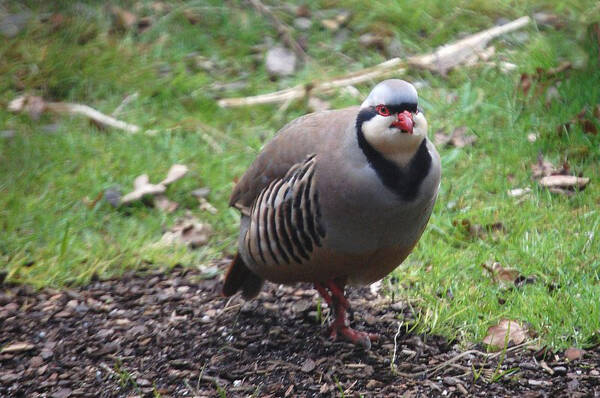Rock Partridge
IUCN
LCBasic Information
Scientific classification
- name:Rock Partridge
- Scientific Name:Rock Partridge,Alectoris graeca
- Outline:Landfowl
- Family:Gallinariformes P.family Grouse
Vital signs
- length:30-37cm
- Weight:370-770g
- lifetime:No textual research information is available
Feature
The forehead has a black band above the chest, the lower body is brown-gray, the flight feathers are white or gray, and there are longitudinal spots of color storage
Distribution and Habitat
Place of origin: Albania, Austria, Bosnia and Herzegovina, Bulgaria, Croatia, France, Germany, Greece, Italy, Macedonia, Serbia, Montenegro, Romania, Slovenia, Switzerland, United States, Canada, Cuba, South Africa, Australia, Mongolia, China, Kazakhstan, Uzbekistan, Iran, Afghanistan, Turkmenistan India, Bhutan, Russia, Croatia, Portugal, Syria, Jordan, Turkey, Azerbaijan, Pakistan, Iraq, Mexico, Malta, Georgia, Tajikistan, Czech Republic, Hungary, Ukraine, Moldova, Palestinian Territory, Bhutan, Kashmir, Saudi Arabia, Armenia.
Introduced: Belgium, Lebanon, Spain. Regional extinction: Liechtenstein. Traveler: Turkey.
In China, it is distributed in the Tianshan, Altai and Kunlun Mountains in northwest, west and southwest Xinjiang, the Qilian Mountains in Qinghai and Gansu, and parts of Tibet and Inner Mongolia.
It inhabits rocky slopes and rocky grassland areas in mountainous and hilly areas facing the sun, but also in forest margins and high mountain areas with more trees. Li
Appearance
Medium chickens, 32-37 cm long. It looks very similar to a quack chicken. The forehead is black, extending to the corners of the mouth; Narrow white or black stripes on the eyes, gray on the crown and back of the neck, with grape pinks; From the forehead, there is a black band passing from the eyes to the ears, and then down the side of the neck, across the lower throat. The black horizontal band separates the white throat from the gray chest, forming a black circle around the throat; The upper back, shoulders, and wings are covered with bluish-gray or dark gray, tinged with deep grape pink, extending down to the breast side; The lower back, waist, and tail are covered with smoke gray or brownish gray, with olive accents; Central 1 pair tail plume smoke gray or light brown gray, the rest tail plume chestnut; Primary feather brown, there is a storage color longitudinal spot. The cheeks are white, the throat is white or herb-white, the chest is pale grey or bluish-grey with pinks or brow
Details
European grouper (scientific name: Alectoris graeca), foreign name Rock Partridge, pheasant family Grouper genus of medium chickens, there are 4 subspecies.

The European grouper likes to flock. Action is very alert and careful, often run along the hillside or up the mountain in case of danger, never run down the mountain, running speed is extremely fast, but also good at hiding. Also fly when in danger, the two wings flap strongly, often make the sound of wings, but also more rapid. Takeoff is accompanied by a loud call, but it usually does not fly far before falling into grass or brush. They rarely fly. They can also stretch out their wings to glide, especially when flying down and landing. In song, the call is a four-syllable musical sound. European stone chickens feed mainly on shoots, young leaves, buds, roots, berries, fruits and seeds of various plants, and also eat small invertebrates such as insects. Usually start activities and foraging after the day is bright, and then go to the water to drink, rest in the shade of shrubs or rocks when the temperature is high at noon, and then start foraging after cool in the afternoon. They usually feed near or near the water.
The breeding period of the European grouse is April-May, the mating begins at the end of February and the beginning of March, and the laying begins in mid-late April. They usually nest in rocky places on cliff slopes, near brush or forest areas, especially in brush or forest slope areas with a few herbaceous plants. The nest is mostly placed on the ground, usually under the cover of shrubs or rocks, and sometimes nests in rock crevices near cliffs. Each clutch lays 7-14 eggs, occasionally as many as 18-19, the eggs are brown or milky, with rust brown spots, the size of the eggs is 35.2-26.4×30.2 mm, an average of 39.0 mm ×29.3 mm. Young birds have sex early and can follow their parents soon after hatching.
Although the total number of European grouse is larger, it is rated as near threatened. In 2004, there were about 120,000-230,000 European cockerels in the world, with 80,000-120,000 mature individuals, and from 1970 to 2004, the total showed a downward trend, especially in Europe, where the rate of decline was the fastest. The main threats are habitat degradation and destruction, the rapid development of modern farming and forestry, the accelerated spread of parasites, poaching and overhunting, extreme weather, damage from tourism, and weakening connectivity between populations.
Listed on the International Union for Conservation of Nature (IUCN) 2016 Red List of Threatened Species ver 3.1 - Near Threatened (NT).
It is listed as a protected species in the European Union and is included in the Red Book of Endangered Animals of Austria, Bulgaria, Croatia, France, Switzerland and Italy.
Protect wild animals and eliminate wild meat.
Maintaining ecological balance is everyone's responsibility!








